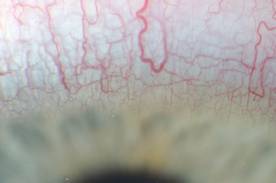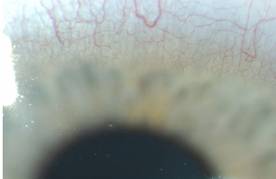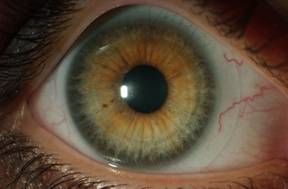| Custom silicone hydrogel (SiHy) lenses represent a major advancement in the contact lens industry. Suddenly, contact lens practitioners have a viable alternative to gas-permeable lenses, low Dk hydrogels, and silicone lenses for high refractive errors and aphakia. Brien Holden was quoted in Optometry and Vision Science earlier this year suggesting that, “[Custom SiHy lenses] will earn the gratitude of the extremely high myopes and pediatric aphakes who need such lenses, and the practitioners who serve them”.1 At present, there are very few peer-reviewed studies on custom silicone hydrogel lenses, but the benefits to the ocular surfaces are expected to mirror previous investigations into these materials.
What we know so far
There are a few key questions that have been answered thus far about silicone hydrogel lenses. Compared to low Dk materials, SiHy provides significantly reduced limbal hyperemia and neovascularization.2,3 Figure 1 shows two biomicroscopic photographs of limbal hyperemia before and after 2 weeks of wear with Lotrafilcon B.
 |
 |
A |
B |
Figure 1A.
Limbal vascularization with habitual hydrogel contact lens wear.
Figure 1B. Limbal vascularization after 2 weeks post-refit into Lotrafilcon B material. Note the looped conjunctival blood vessel for orientation. There is a reduction in the mass of conjunctival vasculature compared to 1A.4
There is no additional corneal edema in daily wear of SiHy lenses in comparison with other lens materials, as demonstrated by the reduction of signs of hypoxia such as microcysts. Previous studies have found that between 30-49% of daily hydrogel lens wearers display signs of microcysts, yet none were found in patients wearing daily SiHy.5
A key indicator which has been established as an objective measure of corneal epithelial damage is tear lactate dehydrogenase (LDH), which is found to be reduced in SiHy wearers.6 Dead, dying or damaged epithelial cells secrete LDH hence a reduction in this chemical suggests that the integrity of the superficial corneal epithelium is maintained more effectively in SiHy wearers than with the use of hydrogel lenses
All of the above factors point to the improved health profile of SiHy lenses. Unfortunately, the rate of the most severe contact lens related complication, microbial keratitis, does not appear to have been reduced with daily wear SiHy in comparison with low Dk materials.7-11
High Refractive Error
Until the present time, we have had limited options with which to fit high prescriptions, and have had to rely mainly upon rigid gas-permeable lenses to allow for long daily wear time. Low Dk hydrogel lenses are available in high powers, but the material properties as well as the edge thickness (in minus lenses) or center thickness (in plus lenses) makes this material undesirable for long term wear. Since data is reported based on a –3.00 D thickness lens, the actual Dk of a high-powered, thick lens is significantly less either centrally or peripherally. There are relatively few circumstances where low Dk hydrogels are indicated, even in aphakia.
 |
| Figure 2 |
A custom SiHy on a phakic patient with +7.00D hyperopia after 2 months of daily wear. Due to the difference in thickness profile of this plus lens which is much thinner in the periphery, we chose to fit the lens with a larger diameter; note the 0.75mm overlap onto the sclera. There is no limbal hyperemia or corneal vascularization. Prior to the custom SiHy, this patient wore a GP lens for 10 years. She commented on the improvement in comfort over her rigid lenses, and interestingly said, “changing lenses every 3 months feels pretty sanitary and right to me.”
Pediatric Aphakia
Sutured IOLs remain a controversial choice with pediatric ophthalmologists. Aphakic contact lens correction is often the first line of treatment following lens removal in children. In my practice, difficult pediatric fits take place in an exam under anesthesia with the ophthalmologist. We fit mostly Silsoft contact lenses when the physiologic lens is first removed. As the child grows and becomes increasingly intolerant to pure silicone lenses, we make the transition to GP lenses. Due to the advent of custom SiHy lenses, we have a new opinion. I would rather transition a child into a custom SiHy than a GP lens due to the improvements in comfort, handling, and reduced chance of dislodging.
Examination under anesthesia (EUA) of a 3 year old boy with unilateral aphakia secondary to open globe trauma. During the EUA I fit him with both soft and GP lenses so that two different options are available for correction of his refractive error.
With the advent of custom silicone hydrogel lenses practitioners now have another viable treatment option for high refractive errors and pediatric aphakia.
References
- Holden B, de la Jara PL. Contact lenses: optimal vision--sub-optimal carrier? Optom Vis Sci. 2007 Apr;84(4):365-7. Review.
- Papas, E.B., C.M. Vajdic, R. Austen, and B.A. Holden, High-oxygen-transmissibility soft contact lenses do not induce limbal hyperaemia. Curr Eye Res, 1997. 16(9): p. 942-8.
- Dumbleton, K., Richter D, Simpson, Fonn D., A comparison of the vascular response to extended wear of conventional lower Dk and experimental high Dk hydrogel contact lenses. Optom Vis Sci, 1998. 75(12s): p. 170.
- Sonsino J. & Janakiramen P. Prospective Comparison of O2 Optix (Lotrafilcon B) Toric Contact Lenses to Biomedics 55 (Ocufilcon D) and Soflens 66 (Alphafilcon A) Toric Contact Lenses. Poster presented at the annual meeting of the European Contact Lens Society of Ophthalmologists, 2006.
- Keay, L., D.F. Sweeney, I. Jalbert, C. Skotnitsky, and B.A. Holden, Microcyst response to high Dk/t silicone hydrogel contact lenses. Optom Vis Sci, 2000. 77(11): p. 582-5.
- Ladage, P.M., K. Yamamoto, D.H. Ren, et al., Effects of rigid and soft contact lens daily wear on corneal epithelium, tear lactate dehydrogenase, and bacterial binding to exfoliated epithelial cells. Ophthalmology, 2001. 108(7): p. 1279-88.
- Poggio, E.C., R.J. Glynn, O.D. Schein, et al., The incidence of ulcerative keratitis among users of daily-wear and extended-wear soft contact lenses. N Engl J Med, 1989. 321(12): p. 779-83.
- Cheng, K.H., S.L. Leung, H.W. Hoekman, et al., Incidence of contact-lens-associated microbial keratitis and its related morbidity. Lancet, 1999. 354(9174): p. 181-5.
- Seal, D.V., C.M. Kirkness, H.G. Bennett, and M. Peterson, Population-based cohort study of microbial keratitis in Scotland: incidence and features. Cont Lens Anterior Eye, 1999. 22(2): p. 49-57.
- Schein, O.D., J.J. McNally, J. Katz, et al., The incidence of microbial keratitis among wearers of a 30-day silicone hydrogel extended-wear contact lens. Ophthalmology, 2005. 112(12): p. 2172-9.
- Stapleton F, K.L., Edwards K, Naduvilath T, Dart J, Brian G, Holden B., Risks of Contact Lens Related Microbial Keratitis. Optom Vis Sci, 2005. 82(E-abstract 050068.)
|